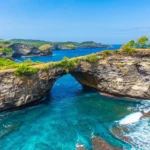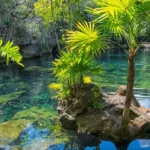Overview of Exploring the Great Barrier Reef, Australia
The Great Barrier Reef, a UNESCO World Heritage site and one of the seven natural wonders of the world, stretches over 2,300 kilometers along the coast of Queensland, Australia. It’s the largest coral reef system on the planet, home to an unparalleled array of marine life. Visitors to the reef can indulge in a variety of activities, ranging from snorkeling and diving to educational tours and cultural experiences. This majestic natural wonder not only offers breathtaking beauty but also a chance to learn about marine conservation and the importance of preserving our natural world.
| Aspect | Details | Additional Information |
|---|---|---|
| Best Time to Visit | June to October (Australian Winter) | Ideal for diving & snorkeling due to clear visibility and mild weather. Outside jellyfish season. |
| Address | Great Barrier Reef, Queensland, Australia | Exact location varies as the reef spans over 2,300 kilometers. Use Google Maps for specific destinations. |
| Ticket Charges | Varies by tour operator; ranges from AUD 150 to AUD 600+ for standard tours | Prices depend on the type of tour (snorkeling, diving, boat tours) and duration. Check with specific operators. |
Snorkeling and Scuba Diving

Snorkeling and scuba diving are quintessential activities for exploring the underwater marvels of the Great Barrier Reef. The clear, warm waters provide visibility for up to 30 meters, offering an unobstructed view of vibrant coral gardens and a myriad of marine species. Divers can explore famous dive sites like the Cod Hole, Ribbon Reefs, and the SS Yongala wreck. These sites offer encounters with giant clams, manta rays, and myriad tropical fish. For beginners, numerous dive schools offer certification courses, ensuring that even novices can safely experience the wonders of the reef. Meanwhile, snorkeling is accessible to people of all ages and skill levels, requiring minimal equipment. Guided tours often include educational components, teaching participants about the reef’s biodiversity and the importance of its preservation.
Glass-Bottom Boat Tours
For those who prefer to stay dry while exploring the reef, glass-bottom boat tours offer a unique opportunity. These boats, equipped with transparent floors, provide a window into the diverse ecosystem below. This is an excellent option for families with small children or anyone unable to swim. Tour guides often provide commentary on the types of coral and marine life visible beneath the boat, making it an educational experience. The tour routes are carefully designed to showcase a variety of coral types and marine habitats. Some tours even include stops at pontoon platforms, allowing passengers to step out and get a closer look at the reef from a stable structure. These tours are also an excellent opportunity for photography enthusiasts to capture the underwater landscape without getting wet.
Helicopter or Seaplane Tours

Aerial tours of the Great Barrier Reef, conducted via helicopter or seaplane, offer a breathtaking perspective of this vast marine ecosystem. From the air, the sheer scale of the reef becomes apparent, with its intricate patterns of coral atolls, clear blue waters, and sandy cays. These tours provide unique photo opportunities of the reef’s stunning array of colors and shapes. Many helicopter tours offer the option of landing on a secluded sand cay for a private beach experience. Seaplane tours might include a low-flying journey over iconic landmarks like Heart Reef, a naturally heart-shaped coral formation. These tours are not only visually spectacular but also educational, as pilots often share information about the reef’s ecology and the challenges it faces due to climate change and other environmental pressures.
Educational Visits to Marine Stations
The Great Barrier Reef is not only a natural wonder but also a significant scientific research site. Several marine stations and research centers on the islands offer educational tours. These tours provide insights into the scientific studies conducted on the reef, covering topics like coral bleaching, marine biodiversity, and conservation strategies. Visitors can interact with marine biologists, witness laboratory work, and sometimes even participate in citizen science projects. Educational visits are particularly valuable for children and young adults, fostering a deeper understanding of and appreciation for marine ecosystems. Some tours also cover the history and impact of human activities on the reef, highlighting the importance of sustainable tourism and conservation efforts.
Island Hopping
The Great Barrier Reef is dotted with numerous islands, each offering unique experiences. From luxurious resorts on islands like Hamilton and Hayman to the untouched natural beauty of Whitsunday and Lizard Islands, there’s something for every type of traveler. Island hopping allows visitors to experience the diversity of the reef’s ecosystem. Many islands offer additional activities like hiking, bird-watching, and cultural tours. Accommodations range from camping and budget options to exclusive, eco-friendly resorts. Island stays often include opportunities for water sports, reef tours, and relaxation on pristine beaches. This activity is an excellent way to combine the exploration of the reef with a relaxing holiday in a tropical paradise.
Underwater Photography

The Great Barrier Reef, with its clear waters and abundant marine life, is a paradise for underwater photographers. Whether you’re a professional or an enthusiast, the reef presents endless opportunities to capture stunning images. The diverse marine life, from tiny nudibranchs to large pelagic fish, provides a range of subjects. Coral formations with their myriad colors and patterns also make for compelling photographs. Many dive operators offer specialized photography tours, providing guidance on techniques and the best spots for capturing unique shots. Equipment rental services are widely available, offering high-quality gear suitable for underwater photography. Capturing the beauty of the reef not only creates lasting memories but can also help in raising awareness about the importance of preserving this fragile ecosystem.
Sustainable Tourism Activities
Participating in sustainable tourism activities is crucial in preserving the Great Barrier Reef for future generations. Many tour operators in the region are committed to eco-friendly practices, such as limiting the number of visitors to sensitive areas, using environmentally friendly fuels, and educating tourists about conservation. Visitors can engage in reef clean-up dives, coral planting activities, and educational workshops. Choosing eco-certified operators and adhering to responsible tourism practices, like not touching the coral and using reef-safe sunscreen, significantly reduces the environmental impact of your visit. By engaging in sustainable tourism, visitors can enjoy the natural beauty of the reef while contributing to its preservation.
Night Tours
Night tours on the Great Barrier Reef offer a unique and enchanting experience. As the sun sets, the reef transforms, with different species of marine life becoming active. Night dives and boat tours allow visitors to observe nocturnal creatures like sleeping turtles, bioluminescent plankton, and predatory fish in action. The experience of seeing the reef under the moonlight is vastly different from daytime tours and is often described as magical. For those who prefer to stay dry, some operators offer night tours on boats equipped with underwater lights, illuminating the reef and its nocturnal inhabitants. These tours are not only a thrilling adventure but also provide insight into the different aspects of the reef’s ecosystem.
Cultural Experiences with Indigenous Communities
The Great Barrier Reef is not only a natural habitat but also a region of cultural significance, particularly for the Indigenous communities of Australia. Engaging with these communities provides a deeper understanding of the reef’s cultural and spiritual importance. Many tours offer the chance to learn about the traditional uses of marine resources, storytelling, and the historical connection of Indigenous people to the reef. Participating in cultural tours led by Indigenous guides is an enriching experience, offering a unique perspective on the reef and its significance beyond its ecological value. This cultural exchange not only enhances the visitor experience but also supports the local communities and their efforts to preserve their heritage and the natural environment.
Frequently Asked Questions About the Great Barrier Reef
What is the best time of year to visit the Great Barrier Reef?
The best time to visit the Great Barrier Reef is during the Australian winter (June to October). During this period, the weather is mild, and the water visibility is at its best, making it ideal for snorkeling and diving. It’s also outside the jellyfish season, reducing the risk of stings.
Do I need a special certification for diving at the Great Barrier Reef?
If you plan to scuba dive, a basic open water diving certification is required. Many operators in the area offer certification courses that can be completed in a few days. For snorkeling, no special certification is needed.
Can beginners participate in diving or snorkeling?
Yes, beginners can participate in both activities. There are numerous tour operators who cater to beginners, providing necessary training and equipment. Introductory diving courses are available for those who have never dived before.
Are there any restrictions on touching the coral or marine life?
Yes, visitors are strongly advised not to touch the coral or any marine life. Touching coral can damage the delicate organisms, and some marine creatures can be dangerous if provoked.
How can tourists contribute to the conservation of the Great Barrier Reef?
Tourists can contribute by choosing eco-friendly tour operators, respecting all wildlife, using reef-safe sunscreen, and participating in conservation activities such as reef clean-up dives. Educating oneself about the reef and its challenges also helps in spreading awareness.
Is the Great Barrier Reef wheelchair accessible?
Many tour operators and facilities are equipped to accommodate visitors with mobility issues, including those in wheelchairs. It’s best to check with tour providers in advance about specific accessibility accommodations.
Are there activities for children at the Great Barrier Reef?
Yes, the Great Barrier Reef is family-friendly, with many activities suitable for children. Glass-bottom boat tours, shallow water snorkeling, and educational programs at marine stations are popular options for families.
How much time should I spend at the Great Barrier Reef?
To fully experience the reef, a stay of at least 3 to 5 days is recommended. This allows time for multiple activities such as snorkeling, diving, island visits, and educational tours.
Is swimming with sharks safe at the Great Barrier Reef?
Shark encounters at the Great Barrier Reef are generally safe, especially with reef sharks, which are commonly seen and are not aggressive towards humans. Guided tours ensure the safety of participants during such encounters.
Can I visit the Great Barrier Reef on a budget?
Yes, there are options for budget travelers, including day trips, snorkeling tours, and visits to more affordable islands. Camping on some islands can also be a cost-effective way to experience the reef.
Remember, the Great Barrier Reef is a delicate ecosystem. As a visitor, you play a crucial role in its preservation by respecting the environment and following sustainable tourism practices.



















